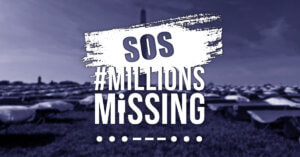On ME Awareness day this year, 12th May, the London School of Hygiene and Tropical Medicine (LSHTM) opened the UK ME/CFS Biobank for business, with blood samples available from 300 patients now, and there will soon be samples for over 200 controls. The ready availability of samples for large numbers of well-characterised patients and controls has the potential to make research faster, easier and better.
The Biobank was set up by LSHTM’s CURE-ME group, headed by Dr Luis Nacul, and including Dr Eliana Lacerda, researcher Erinna Bowman and research nurse Caroline Kingdon. It’s been years in the making, with recruitment starting in 2012. UK charities Action for ME, The ME Association, ME Research UK and a private donor funded the Biobank from the off, and a £1 million grant from the US National Institutes of Health (NIH) funded a major expansion.
Getting patients and samples can be the biggest hurdle in biomedical research
Often the hardest, most expensive, slowest – and yet perhaps the most important – part of a research study is assembling samples from a group of well-diagnosed patients. The Biobank can jump-start the research process by providing ‘off the shelf’ patient samples that can be shipped anywhere in the world. Almost all the Biobank patients meet Canadian consensus criteria, and researchers can pick and choose samples according to criteria. Not only is this much faster and more convenient for researchers, it allows them access to large numbers of patients, which is critical in a field that has been plagued by small sample sizes and unreliable results.
New blood for new blood
The Biobank makes it much easier for new researchers to come into ME/CFS research from other fields, as they now have a straightforward way access to patient samples (subject to Biobank approval of proposals). And attracting new talent to ME/CFS, to speed up progress, is a priority for the NIH in the US, the MRC in the UK, and patients too.
The Biobank could also make the tedious work of replication much easier. Any promising finding, such as a potential biomarker, needs replicating on a new group of patients to see if it represents real progress or is a false positive. The Biobank makes finding that new group of patients a great deal easier, paving the way for more replications and therefore more reliable research findings.
Enough blood to launch a wave of large studies

The Biobank is big enough to potentially power a wave of new, large studies that would significantly change the research landscape. Size matters in research studies and bigger is better (for rather tedious statistical reasons). Big studies can detect smaller, but important, differences small studies would miss, as well as having the power to find subgroups – something incredibly important in ME research. Also, findings from small studies are also more likely to be false positives, and where they do find a real effect, it’s likely to be smaller than the study finds.
To put the Biobank’s potential to enable bigger studies into perspective, the largest biomedical study in recent times is Dr Mady Hornig and Dr Ian Lipkin‘s cytokine signature study last year, with almost 300 patients. There are 300 patients in the UK ME/CFS Biobank, with 40 samples for each patient (and control) so it could power many studies this size. The Lipkin/Hornig study needed two samples for each person in the study and if that’s typical then the 40 samples for each Biobank subject could power twenty such studies, each with 300 patients. Or it could power 60 studies with 100 patients each, still large by current standards.
The Biobank could power twenty huge studies with 300 patients each, or sixty large studies with 100 patients each
That would be game-changing. Of course, the key work is done by the researchers themselves, but the Biobank provides the all-important infrastructure that suddenly makes large studies much easier to pull off.
These examples are just illustrations of what’s possible but it gives you an idea of how much research the Biobank might power.
Five reasons the Biobank samples are so valuable
-
Quality counts

The UK ME/CFS Biobank is nested within a much larger biobank run jointly by University College London and the Royal Free Hospital, and the CURE-ME team drew on this expertise to develop its own rigorous protocols. These set out strict standards for how samples are collected, transported (within just six hours!) and processed, before being stored in liquid nitrogen. Similarly-strict protocols detail how patients are recruited, tested and assessed. The result is high quality samples from a well-diagnosed patients.
Patients are recruited with an initial diagnosis by their own doctor, but the Biobank uses further blood tests, a clinical assessment and questionnaires to confirm this. Almost 90% of patients meet Canadian consensus criteria and researchers can select patients using three other criteria too, including Fukuda.
-
A wealth of data
The Biobank assessment yields a wealth of clinical data for every patient. There are the results of blood and urine tests used to rule out other diagnoses, such as the tests for thyroid function, and C-reactive protein. On top of that comes symptom data, clinical history, whether onset is sudden/ infectious or gradual and clinical measurements including weight, pulse and blood pressure. The combination of so much data amplifies the value of each patient to researchers who will be able to correlate their findings such as cytokine levels with say, symptom severity, illness duration or type of onset.
“It has become a world leader in this area of research when it comes to the quality of the blood samples, the range of blood constituents it can provide, and the high quality clinical data that accompanies the samples.”
Dr Charles Shepherd, The ME Association.
-
Ability to study severely-affected patients

The CURE-ME group has gone to great lengths to recruit severely-affected patients, with fifty patients providing samples to the bank after being assessed in their own homes. This gives researchers access to a critically important and much neglected group of patients. Ron Davis has argued that, as in other illnesses, more severely ill patients will have a stronger biological ‘signal’ of the disease, making it easier to spot what’s going wrong (and his early results from studying these patients are very promising).
-
Tracking patients over time
Thanks to the NIH, 60% of Biobank patients have samples collected at two different times, rather than a single sample, allowing researchers to track changes in symptoms and biomarkers over time. The team are trying to get funding for even more repeat samples.
-
Sick as well as healthy controls
Most ME/CFS studies compare patients with those who are healthy. Unfortunately, some differences with healthy controls may simply be general changes due to ill-health, rather than revealing something specific about the illness. The Biobank includes 75 multiple sclerosis patients – often seen as a relevant comparison group for ME/CFS – allowing researchers to see if effects they find might be related to ill-health generally, or are more likely to be unique to the illness.
ME’s curious return to its roots
The ME Association are funding the Biobank’s core costs for the next two years from its Ramsay Research Foundation, named in honour of Dr Melvin Ramsay. It was Ramsay who named ME following the outbreak among medical staff at the Royal Free Hospital in 1955 – the same Royal Free Hospital that now homes the ME/CFS Biobank.
Going global
The UK ME/CFS Biobank is one part of a growing international network of biobanks. It already has links with the Norwegian ME/CFS biobank in Oslo, and there are plans are for biobanks in other countries, including Germany, Italy, Spain, Latvia and more. CURE-ME are working with European partners on a common, shared protocol for all biobanks so that samples from different banks can be pooled, allowing researchers to create huge new samples. The US already has a bank, with Solve ME/CFS Initiative’s biobank.
The UK ME/CFS Biobank is now ready to supply samples to researchers, who have already made enquiries, and the biobank is currently waiting to receive the first full applications for samples. Watch for a wave of new large studies in the coming years.
Follow Simon McGrath (@sjmnotes) on twitter
Thanks to Dr Eliana Lacerda for providing information – any errors are mine. Unless labelled otherwise, photos are stills from the included Biobank video.
Save
Save
Save





7 thoughts on “The UK ME/CFS biobank paves the way for bigger and better research”
Hi, are you still recruiting for patients/samples? I would like to take part and donate if so. Thanks. Debbie
Hi, I’m interested in taking part for research, I’m severe but I would do it..
Thanks, Debbie and Ann. They have already recruited all the mecfs patients they need, including the severe patients.
The Biobank also mainly recruits from primary practice (people’s local NHS doctor in the UK): using this approach they are more likely to get a representative sample of patients – which is actually the 6th reason the Biobank is so valuable (but the list was getting a bit long, so I stopped at 5 reasons). The severe patients were recruited via London self-help groups, as that made it practical for the research nurse to visit patients for assessment and to take samples.
Outstanding summary, Simon! Much appreciated!
Thanks, Gemini, appreciated.
it took 4 years to tell me.. i got cfs/me.. thenn thats it was left wobbling with a stick.. knackered all day long.. i changed docters.. he dont get it.. and all i have is pain killers strong ones.. to help me go through my day.. and he tryin to take me off them.
I’m sorry to hear that, Katharine. Pain is the worst to deal with, imo.
Comments are closed.